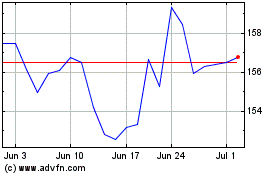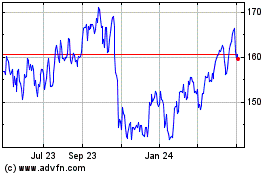Chevron Corporation (NYSE: CVX), through its Chevron New
Energies International Pte. Ltd. (Chevron) subsidiary, and Mitsui
O.S.K. Lines, Ltd. (MOL) today announced the signing of a Joint
Study Agreement (JSA) on the feasibility of transporting liquified
carbon dioxide (CO2) from Singapore to permanent storage locations
offshore Australia.
This press release features multimedia. View
the full release here:
https://www.businesswire.com/news/home/20221109006052/en/
Chevron and MOL have signed a Joint Study
Agreement to explore the feasibility of transporting liquified
carbon dioxide from Singapore to permanent storage locations
offshore Australia. At the signing ceremony in Singapore were Mr.
Chris Powers, Vice President, Carbon Capture Utilization and
Storage, Chevron New Energies, and Mr. Yasuchika Noma, Executive
Officer of MOL. (Photo: Business Wire)
Under the JSA, Chevron and MOL will explore the technical and
commercial feasibility of initially transporting up to 2.5 million
tonnes per annum (Mtpa) of liquified CO2 by 2030.
The JSA will complement work to be advanced by a recently
announced consortium to explore solutions for large-scale carbon
capture, transport and permanent storage of CO2 from Singapore.
Through its part in three joint ventures, Chevron was also recently
granted an interest in three greenhouse gas assessment permits
offshore Australia.
“Developing safe and reliable CO2 transportation services is a
crucial step in developing large scale Carbon Capture, Utilization,
and Storage (CCUS) solutions. We are pleased to partner with MOL to
explore commercially-ready solutions to focus on realizing this
goal,” said Mark Ross, president of Chevron Shipping Company.
“We expect this agreement with MOL to advance the technical and
commercial foundations for a regional approach to CCUS, which could
provide progress toward the region’s net-zero ambitions. No single
entity has all the solutions, but genuine collaboration can help us
unlock opportunities as we advance our shared goal of a lower
carbon future,” said Chris Powers, vice president, CCUS, Chevron
New Energies.
“As a developer and a provider of social infrastructure service
in addition to traditional shipping, MOL is honored and excited to
have an opportunity to collaborate with Chevron for opening up CCUS
solutions in the Asia Pacific region. We hope to expand our
collaboration to wider areas of solutions for decarbonization
including CCUS and renewable energies globally,” said Yasuchika
Noma, Executive Officer of MOL.
About Chevron
Chevron (NYSE: CVX) is one of the world’s leading integrated
energy companies. We believe affordable, reliable, and ever-cleaner
energy is essential to achieving a more prosperous and sustainable
world. Chevron produces crude oil and natural gas; manufactures
transportation fuels, lubricants, petrochemicals and additives; and
develops technologies that enhance our business and the industry.
We are focused on lowering the carbon intensity in our operations
and growing lower carbon businesses along with our traditional
business lines. More information about Chevron is available at
www.chevron.com.
About MOL
Mitsui O.S.K. Lines is a global leading shipping company
operating about 800 ships across the world, headquartered in Japan.
MOL develops various social infrastructure businesses centering on
ocean shipping, technologies and services to meet ever-changing
social needs including environmental protection. MOL fleet includes
dry cargo ships, liquefied natural gas carriers, Ro-Ro car carrier
ships, oil tankers, etc. In addition to the traditional shipping
businesses, MOL offers social infrastructure businesses such as
real estate, terminal and logistics, offshore wind power, and
associated businesses. With one of the largest merchant fleets,
130-plus years of history, experience, and technology, MOL group
aims to be a strong and resilient corporate group that provides new
value to all stakeholders. For more information about Mitsui O.S.K.
Lines, Ltd, please visit https://www.mol.co.jp/en/index.html.
CAUTIONARY STATEMENTS RELEVANT TO
FORWARD-LOOKING INFORMATION FOR THE PURPOSE OF “SAFE HARBOR”
PROVISIONS OF THE PRIVATE SECURITIES LITIGATION REFORM ACT OF
1995
This news release contains forward-looking statements relating
to Chevron’s operations and energy transition plans that are based
on management's current expectations, estimates and projections
about the petroleum, chemicals and other energy-related industries.
Words or phrases such as “anticipates,” “expects,” “intends,”
“plans,” “targets,” “advances,” “commits,” “drives,” “aims,”
“forecasts,” “projects,” “believes,” “approaches,” “seeks,”
“schedules,” “estimates,” “positions,” “pursues,” “may,” “can,”
“could,” “should,” “will,” “budgets,” “outlook,” “trends,”
“guidance,” “focus,” “on track,” “goals,” “objectives,”
“strategies,” “opportunities,” “poised,” “potential,” “ambitions,”
“aspires” and similar expressions are intended to identify such
forward-looking statements. These statements are not guarantees of
future performance and are subject to certain risks, uncertainties
and other factors, many of which are beyond the company’s control
and are difficult to predict. Therefore, actual outcomes and
results may differ materially from what is expressed or forecasted
in such forward-looking statements. The reader should not place
undue reliance on these forward-looking statements, which speak
only as of the date of this news release. Unless legally required,
Chevron undertakes no obligation to update publicly any
forward-looking statements, whether as a result of new information,
future events or otherwise.
Among the important factors that could cause actual results to
differ materially from those in the forward-looking statements are:
changing crude oil and natural gas prices and demand for the
company’s products, and production curtailments due to market
conditions; crude oil production quotas or other actions that might
be imposed by the Organization of Petroleum Exporting Countries and
other producing countries; technological advancements; changes to
government policies in the countries in which the company operates;
public health crises, such as pandemics (including coronavirus
(COVID-19)) and epidemics, and any related government policies and
actions; disruptions in the company’s global supply chain,
including supply chain constraints and escalation of the cost of
goods and services; changing economic, regulatory and political
environments in the various countries in which the company
operates; general domestic and international economic, market and
political conditions, including the military conflict between
Russia and Ukraine and the global response to such conflict;
changing refining, marketing and chemicals margins; actions of
competitors or regulators; timing of exploration expenses; timing
of crude oil liftings; the competitiveness of alternate-energy
sources or product substitutes; development of large carbon capture
and offset markets; the results of operations and financial
condition of the company’s suppliers, vendors, partners and equity
affiliates, particularly during the COVID-19 pandemic; the
inability or failure of the company’s joint-venture partners to
fund their share of operations and development activities; the
potential failure to achieve expected net production from existing
and future crude oil and natural gas development projects;
potential delays in the development, construction or start-up of
planned projects; the potential disruption or interruption of the
company’s operations due to war, accidents, political events, civil
unrest, severe weather, cyber threats, terrorist acts, or other
natural or human causes beyond the company’s control; the potential
liability for remedial actions or assessments under existing or
future environmental regulations and litigation; significant
operational, investment or product changes undertaken or required
by existing or future environmental statutes and regulations,
including international agreements and national or regional
legislation and regulatory measures to limit or reduce greenhouse
gas emissions; the potential liability resulting from pending or
future litigation; the company’s future acquisitions or
dispositions of assets or shares or the delay or failure of such
transactions to close based on required closing conditions; the
potential for gains and losses from asset dispositions or
impairments; government mandated sales, divestitures,
recapitalizations, taxes and tax audits, tariffs, sanctions,
changes in fiscal terms or restrictions on scope of company
operations; foreign currency movements compared with the U.S.
dollar; higher inflation and related impacts; material reductions
in corporate liquidity and access to debt markets; the receipt of
required Board authorizations to implement capital allocation
strategies, including future stock repurchase programs and dividend
payments; the effects of changed accounting rules under generally
accepted accounting principles promulgated by rule-setting bodies;
the company’s ability to identify and mitigate the risks and
hazards inherent in operating in the global energy industry; and
the factors set forth under the heading “Risk Factors” on pages 20
through 25 of the company’s 2021 Annual Report on Form 10-K and in
subsequent filings with the U.S. Securities and Exchange
Commission. Other unpredictable or unknown factors not discussed in
this news release could also have material adverse effects on
forward-looking statements.
View source
version on businesswire.com: https://www.businesswire.com/news/home/20221109006052/en/
Chevron: Cam Van Ast cameron.vanast@chevron.com
MOL: Media Relations Team, Corporate Communication
Division TEL: +81-3-3587-7015 E-mail: mrtmo@molgroup.com
Chevron (NYSE:CVX)
Historical Stock Chart
From Apr 2024 to May 2024

Chevron (NYSE:CVX)
Historical Stock Chart
From May 2023 to May 2024
